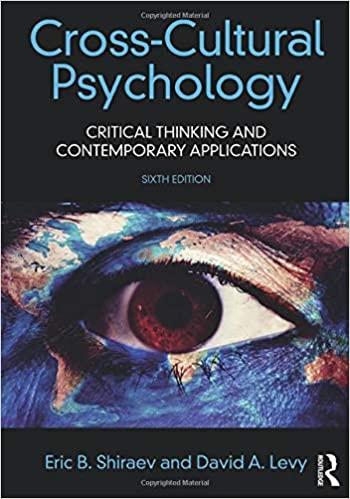Question
Discussion 1 Jeremy has been increasingly difficult to manage since nursery school. At school, he teases and kicks other children, trips them, and calls them
Discussion 1
Jeremy has been increasingly difficult to manage since nursery school. At school, he teases and kicks other children, trips them, and calls them names. He is described as bad tempered and irritable, though at times he seems to enjoy school. Often he appears to be deliberately trying to annoy other children, though he always claims that others have started the arguments. He does not get in serious fights but does occasionally exchange a few blows with another child.
Jeremy sometimes refuses to do what his two teachers tell him to do, and this year he has been particularly difficult during arithmetic, art, and science lessons. He gives many reasons why he should not have to do his work and argues when told to do it. At home, Jeremy's behavior varies. Some days he is defiant and rude to his mother, needing to be told to do everything several times, though he usually complies eventually. Other days he is charming and volunteers to help, but his unhelpful days predominate. His mother says, "The least little thing upsets him, and then he shouts and screams." Jeremy is described as spiteful and mean with his younger brother, Rickie. His mother also says that he tells many minor lies, though when pressed he is truthful about important things. (Source: DSM Casebook: A Learning Companion to the Diagnostic and Statistical Manual of Mental Disorders, Fifth Edition. American Psychiatric Association, 2013.)
- Compose three open questions you would want to ask Jeremy and his mother during your assessment that will invite them to expand upon their perspective of the presenting problem. Consider ways to phrase questions that will help you assess the biological and social risk factors for conduct and oppositional defiant disorders. Provide a brief rationale for each question.
- Identify a potential diagnosis for Jeremy including the psychosocial and environmental problems (V and Z codes) that would be important to provide a holistic description of the context of the focus of treatment.
- Include any information you learned from using the Differential Diagnosis tool, which you can find in the Differential Diagnosis by the TreesLinks to an external site.reading list.
Support your ideas with references to the course texts, articles from this learning week, articles from the Optional Readings, or articles from peer-reviewed journals that you locate in the Capella University LibraryLinks to an external site.. Refer to the Counseling & MFT Masters Research GuideLinks to an external site.and the COUN5107 Reading List.
Response Guidelines
Respond to the main discussion posts of at least one learner who presented different trends. What reactions do you have to the ideas they have presented? Include examples from the course readings or your own experience to support your perspective, and raise questions to continue the dialogue.
Discussion 2
Teen drug use remains below pre-pandemic levels. Reported use for almost all substances decreased dramatically between 2020 and 2021, after the onset of the COVID-19 pandemic and related changes like school closures and social distancing. In 2022, most reported substance use among adolescents held steady at these lowered levels, and these latest data show that this trend has continued this year. In 2023, 10.9% of eighth graders, 19.8% of 10th graders, and 31.2% of 12th graders reported any illicit drug use in the past year.
Marijuana and hallucinogen use, binge drinking, reach historic highs among adults 35-50. Adults aged 35 to 50 continued a long-term upward trajectory in past-year use of marijuana and hallucinogens to reach all-time highs in 2022, according to the Monitoring the Future Panel Study, an annual survey of substance use behaviors and attitudes of adults 19-to-60 years old. Marijuana use and vaping were at their highest historic levels among younger adults aged 19 to 30 in 2022, with reports of past-year marijuana and hallucinogen use as well as marijuana and nicotine vaping significantly increased in the past five years.
Review the most recent publication of the Monitoring the Future National Survey on Drug Abuse from your Week 10 readings. After reviewing the Key Findings of the most recent survey, address the following:
- What trends stand out as most in need of attention for prevention interventions?
- What trends stand out as pointing toprogress already made in prevention?
- How did the study confirm or disconfirm what you anticipated about current trends in adolescent use and experimentation?
Response Guidelines
Respond to the main discussion posts of at least one learner who presented different trends. What reactions do you have to the ideas they have presented? Include examples from the course readings or your own experience to support your perspective, and raise questions to continue the dialogue.
Step by Step Solution
There are 3 Steps involved in it
Step: 1
The question is incomplete as it contains multiple discussion promp...
Get Instant Access to Expert-Tailored Solutions
See step-by-step solutions with expert insights and AI powered tools for academic success
Step: 2

Step: 3

Ace Your Homework with AI
Get the answers you need in no time with our AI-driven, step-by-step assistance
Get Started


